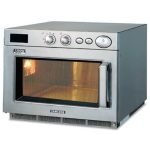

How commercial microwaves help the food industry
Microwaves are indispensable in any commercial kitchen. They are essential for reheating frozen or chilled food, which is the mainstay of pub, takeaway, cafe and hotel catering. Since the early 1970s, their affordability and functionality has made them an essential appliance which has revolutionised how we cook, not only at home, but in professional catering environments.
Microwave only ovens
Microwave only ovens are generally used for reheating chilled or frozen food, but tend not to be used for primary cooking operations. However, they are incredibly versatile, some high end versions are fitted with over 30 different programs and settings. The ability to reheat food in large volume commercial microwaves significantly increases your options in terms of menu versatility. You can prepare many dishes, or components of dishes in advance and rely on the microwave to reheat them whenever someone orders.
Unstructured food like soups, stews and many sauces and gravies can be prepared in advance and reheated immediately prior to serving. Takeaway food like curries and vegetable based braises can all be prepared in advance and frozen in tubs, ready to be microwaved at the last minute.
Components of dishes can also be frozen and reheated in the commercial microwave. For example, onions can be cooked and caramelised, then reheated and added to gravies or pasta sauces at the last minute. At Christmas, parsnips and potatoes can be parboiled and frozen well in advance, then defrosted and roasted as normal. This cuts down on a lot of hob space and prep time on the actual day.

Combination microwave ovens
Combination microwave ovens include a grill and convection heat functionality, as well as the basic microwave operations. This technology transforms the basic microwave into a multi-purpose oven, which can perform most of the functions of a conventional oven with the convenience of a microwave.
One of the main ways in which catering establishments use combination microwave ovens is for crisping. Jacket potatoes can be cooked and softened using the microwave settings, then crisped and browned using the grill setting.
Tarts and pastries can be reheated and then finished in this way too. Potato topped pies, such as fish pie and cottage pie can be reheated and crisped up.
The wattage of commercial microwaves is much higher than domestic machines tend to be. Generally speaking, the highest wattage of a domestic machine is 900 watts, whereas commercial machines range anywhere from 900 to 2000 watts. The high wattage of commercial microwaves means they take much less time to reheat or cook large volumes of food.
Combination microwaves also have preset cooking options, which can be programmed in advance. This makes it possible for any member of staff to easily be able to prepare the dishes in the correct way.
It is unthinkable nowadays to run a busy catering business without the need for one or more microwaves. There is bound to be a model perfect for your budget, as well as your business.


Validate your login
Login
Create New Account